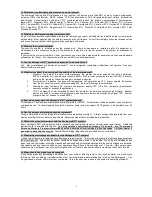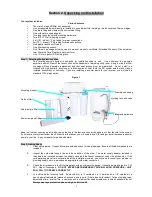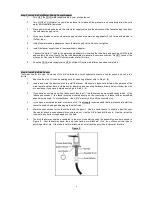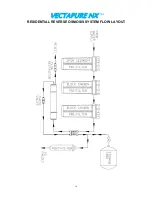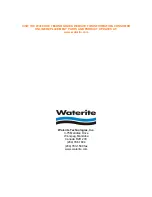
2
Q: What other contaminants does reverse osmosis remove?
The combined filtering and RO processes in your system will remove more than 98% of many organic compounds,
including THMs (chloroforms), DBCP, lindane, TCE (trichloroethylene), PCE (tetrachloroethylene), carbon tetrachloride
and chlorine. Conservatively, Vectapure™ TFC membranes will remove the following percentages of contaminates:
Barium 97%, Potassium 92%, Bicarbonate 94%, Radium 97%, Cadmium 97%, Selenium 97%, Calcium 97%, Silicates
96%, Chromium 92%, Silver 85%, Copper 97%, Sodium 92%, Detergents 97%, Strontium 97%, Fluoride 90%, Sulphates
97%, Lead 97%, PCBs 97%, Magnesium 97%, Insecticides 97%, Nickel 97%, Herbicides 97%, Nitrates 80%, Total
Dissolved Solids 97%.
Q: What does RO treated drinking water taste like?
As most of the chemicals, organics and minerals are removed, your water will taste similar to distilled water or low-mineral
bottled water. Most people enjoy the natural flavour and the soft texture. You will immediately notice that brewed coffee
and juices from concentrate have a greatly enhanced taste and aroma.
Q: Where is the system installed?
Typically, the system is installed under the kitchen sink. Some homeowners or installers prefer the basement or
crawlspace, as this conserves storage in the kitchen and may allow for easier access to the system for maintenance
purposes.
If you install the system more that 20’ from your faucet, you may need a product water booster pump to ensure adequate
pressure at the faucet. Your dealer can provide you with this optional equipment.
Q: Can the Vectapure NX™ system be connected to an extra faucet?
Yes. Many installations will include an optional ¼” line to refrigerator icemakers or additional sink faucets.
See your
dealer for
advice and parts
.
Q: What factors affect the quantity and the quality of the water produced?
1.
Pressure: The greater the water system pressure, the greater the water quantity that will be produced.
60PSI is optimal, but it should never exceed 90PSI. Where water pressures are low (<40PSI), a booster
pump on the raw water line can be added to increase production.
2.
Temperature: Production increases with temperature, the optimal being 76F. Never operate the system
from the hot water line or with water exceeding 85F, as this will damage the membrane.
3.
Membrane type: Vectapure NX system uses premium quality TFC (Thin Film Composite) membranes,
specially chosen for household applications.
4.
TDS: The higher the Total Dissolved Solids in the raw water, the lower the output of product water. Booster
pumps are used to increase system pressure and overcome lower output caused by higher TDS. System
pressure may not however, exceed 90PSI.
Q: How much water does the Vectapure NX™ system produce?
All Vectapure™ systems use
membranes nominally rated for 75GPD. Actual output will be dependent upon the factors
explained above. In optimal applications (with a booster pump) you may expect 60-70 gallons to be available over 24
hours.
Q: Can the amount of water produced be increased?
Filling a water pitcher for the refrigerator will allow more production overnight. A larger holding tank (available from your
dealer) will allow for more water to be on hand. Booster pumps will also increase daily production.
Q: What is the standard warranty with the Vectapure NX™ system?
Every Vectapure NX™ system comes with a standard one-year limited warranty on all parts and repair labour. A detailed
warranty card is included with the unit.
You may purchase and extended warranty if you wish - see the enclosed
Extended Warranty Program information sheet and enrolment form included in your package. Call your dealer if
you wish to have one sent to you
. Normal filter cartridge replacement is excluded from your warranty.
Q: What is the maintenance schedule for the Vectapure NX™ system?
A good rule of thumb is to replace all pre-filters every three months. This is critical to ensure that chlorine does not attack
the membrane film. The carbon post-filter should be changed every three to six months. When the old cartridges have
been removed, the system should be cleaned and sanitized with chlorinated water before the new cartridges are installed.
Dependent upon local water conditions, your membrane should have a life expectancy of 1-5 years
.
More severe water
conditions (iron, hardness) may shorten this significantly; soft water sources may allow a membrane life of up to 8 years.
Q: When should the membrane be changed?
If you notice gradually decreasing production from your system, differing taste to your drinking water or a white scale
forming on
pans or dishes, it probably means that your membrane is deteriorating and is losing its effectiveness. You
may purchase a pocket TDS meter from your dealer - this is the best way to assure you system is operating efficiently.



